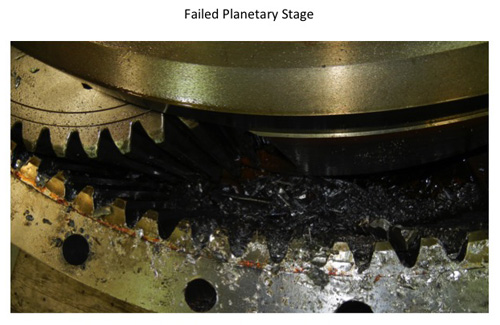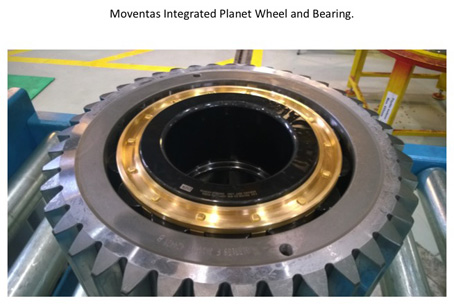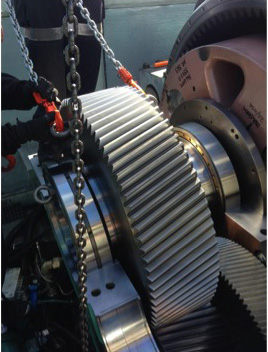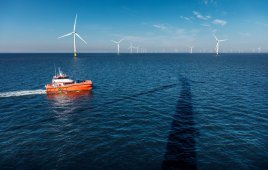Not too many years ago, working up-tower on a wind turbine was challenging if not impossible. Nacelles weren’t designed for easy access. If anything needed fixing inside, whether it was a high-speed shaft or an intermediate bearing, down came the gearbox.
What Mark Eagle, General Manager of Moventas, remembers most about those early days in the wind industry, were the costs. “Everybody knows crane costs are very expensive. When gearboxes came down-tower, they got a full-blown repair. Nobody was going to bring down a gearbox and not replace all the bearings,” he shared during a presentation he gave at a recent O&M Summit in Dallas, organized by Wind Energy Update.
Lost production was also an issue, between sending engineers back and forth to remote locations and transporting the cranes and equipment required for the job, repair to a single bearing could add up to several works days or weeks. Fortunately, times have changed.
“Now, we’re able to do a lot of repairs up-tower that traditionally never would have been done,” said Eagle. “High-speed shaft bearings, now almost everyone is doing that. High-speed shaft gear replacement, a little more difficult and it depends on the type of gearbox you have, but today it is possible.” Eagle explained that the intermediate shaft bearing on the rotor side of a turbine is tough to get at, but engineers today are even changing the intermediate and low-speed shaft of a gearbox assembly without removing the gearbox from the nacelle. In some machines, it’s even possible to get into the planetary stage up-tower.
“The reason why this is possible is because of the development of specialized tooling. How many of you would have thought you would see a crane on top of a wind turbine?” asked Eagle. “It’s pretty hard to believe that would exist a few years ago, but it does exist today.”
Technology has come a long way and is certainly impressive, but most repair decisions on turbines come down to costs. During his talk, Eagle compared the expenses for a full helical repair as an example, which could be around $125,000 up-tower with the components or it could be closer to $300,000 down-tower, depending on the variables.
“There’s a lot of money to be saved by doing up-tower repairs,” he said. Eagle broke down the key factors to consider when determining whether up-tower repairs are possible on a turbine.
- Identify the problem. If you let a failure run for long enough in a wind turbine, it will cause secondary damage and eventually destroy the other components. “By catching defects early enough, you can go in and fix them, and save a ton of money,” he said. “Condition monitoring is going to be the key for that.”
- Conduct a detailed inspection. After a problem in the turbine has been correctly identified, it’s necessary to determine whether an up-tower repair is the right solution. This requires extremely skilled technicians who understand what they’re looking at, stressed Eagle. “If you go up-tower and start changing bearings and components only to find out there’s a broken planet wheel, well…you’ve just wasted a lot of time and money because, most likely, the gearbox has to come out of the turbine,” he said.
- Upgrade when possible. Replace damaged parts with equal or better components to save costs in the long-term rather than just the short-term.
Along with using quality parts, Eagle stressed that it’s vital to keep gearbox oil clean and free of water contaminants for the longevity of the planetary stage. The planetary stage of a gearbox rotates slowly and is the most expensive part. Repairing it up-tower is possible, but challenging. “One problem that you’re dealing with is something called boundary lubrication, and this is why water and contamination are such big factors,” This lubrication condition occurs when moving surfaces, such as gear teeth, are insufficiently separated by the lubricating oil so they contact and small particles wear off. Eagle referred to the example of hydroplaning in a car. While that is bad for cars, it’s good for gears.
“We want hydro-dynamic lubrication to occur. We want to slide over that water patch in our car,” he said. “The reason is oil separates the surfaces of our gear components. Rough teeth or asperities on the teeth rubbing against each other create more wear. Because the planetary gears turn slowly, their metal gear-tooth surfaces are contacting each other.” Eagle said there isn’t an oil on the market that can permanently separate those surfaces in a gearbox. Debris doesn’t flush out easily and accumulates in the planetary stage, encouraging more wear.
 “The surprise is, it’s not your gears that fail. It’s the bearings inside your planets that are the most critical part,” he said. “This is why it’s important to keep the gearbox oil clean.”
“The surprise is, it’s not your gears that fail. It’s the bearings inside your planets that are the most critical part,” he said. “This is why it’s important to keep the gearbox oil clean.”
Wear occurring in the planetary stage doesn’t get easily flushed away with oil circulation, but tends to settle on the bottom of the ring gear. Each time the gears churn by, metal is stirred into the oil, which becomes even more abrasive. “Here you can see the debris in the bottom of a failed planetary stage,” said Eagle referring to the image shown here. “Both coarse and fine particles have been accumulating over time. Eventually the gear teeth break catastrophically.”
To mitigate boundary lubrication, Eagle suggested using a harder surface of the gear. “All manufacturers will use carburized gears throughout their gearbox, but when it comes to the ring gear many manufacturers choose other materials and hardening processes. As a result they don’t have as much durability in an environment with a lot of contamination,” he said. “Once contamination builds up in the oil, it eventually fails the gearbox bearings.”
Another option he explained is to increase the bearing size. If they were increased by as little as one catalog size, which is about 8%, the dynamic rating would result in an approximate 16% increase in life. “When you run the L10 life calculation, you will double the life, all by increasing one bearing size.” (Editor’s note: L10 is the basic rating life attributed to a bearing in an application with a 10% failure probability or 90% reliability.)
Size, however, can be a problem. “The bore of the planet wheel can only be so big before you start to lose the rim thickness, and the gear teeth will crack,” he said. This limits the size of the bearing that can be used.
 According to Eagle, another way to get more capacity in the planetary stage of a gearbox is to use an integrated bearing. Instead of going with a bearing that has an outer race, it’s possible to grind the outer race into the planet wheel. “It’s a little bit more difficult because now you have to grind this bearing race, but when you’ve done that, you can put a larger bearing inside and double the L10 life. That’s a significant upgrade.”
According to Eagle, another way to get more capacity in the planetary stage of a gearbox is to use an integrated bearing. Instead of going with a bearing that has an outer race, it’s possible to grind the outer race into the planet wheel. “It’s a little bit more difficult because now you have to grind this bearing race, but when you’ve done that, you can put a larger bearing inside and double the L10 life. That’s a significant upgrade.”
So, what is the future for up-tower repairs? Eagle pointed out the progress that’s been made over the years, and noted that gearbox failures are now less than 5%, which is a huge drop compared to years past. New designs and technologies are continually being developed, including a gearbox from Moventas that uses five planet wheels instead of three. “Five planet bearings spread the load,” said Eagle. “There’s five bearing sets in there, so instead of being one-third the load, there’s one-fifth the load on those bearings. This is a design that will allow the gearbox to handle a lot more torque and provide more durability.”
Moventas has been using carburized ring gears since 1980 and integrated bearings since 2000, and offers modernizations and upgrades for most wind turbines. “It does show that there’s better life,” concluded Eagle. “These are some of the things that you should consider when approaching up-tower repair and selecting replacement gearboxes.”
Moventas
www.moventas.com
Filed Under: Bearings, Gearboxes, Nacelle, O&M




